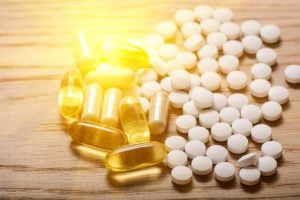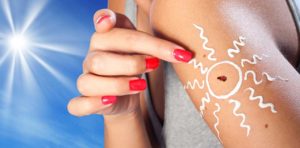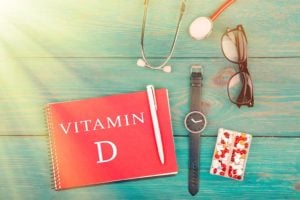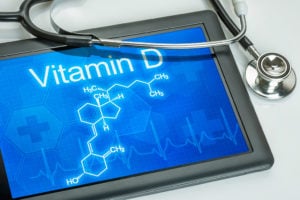Guidelines for Sun Exposure and Vitamin D Levels with World Authority Dr. Michael Holick
Sun exposure offers health benefits that cannot be obtained from vitamin D supplementation. However, most won’t be able to obtain all the vitamin D they need via sun exposure. Fortunately, Dr. Michael Holick provides us with guidelines on how to strike the optimum balance of sun exposure and vitamin D supplementation.
Dr. R’s Fast Facts
Sun exposure provides health benefits not obtained via vitamin D supplementation.
- Reduced risk of: melanoma, all cause mortality, breast cancer, blood pressure, MS, obesity & Type II Diabetes
- Increased risk of: non-melanoma skin cancer
Sunlight
- Variables
- Time of day, season, latitude, degree of skin pigmentation
- D Minder App – tells you when you can make vitamin D anywhere on the planet
If you get a light pinkness to your skin 24 hours after sun exposure in a bathing suit on the beach, it’s called a minimal erythemal dose.
- Equivalent to ingesting about 20,000 units of vitamin D
Health benefits associated with sun exposure that you do not get from solely supplementing with vitamin D:
- When exposed to sunlight, you produce beta endorphin, this is what makes people “feel better” in the sunlight.
- When exposed to sunlight, you make nitric oxide, which is a natural way of reducing blood pressure. This results in feeling more relaxed.
- A whole host of other important biochemicals in your skin that may be important for your health.
Could some of this be tied to living in a blue zone/green zone?
- Earlier studies in 1915 showed that outdoor workers had significantly less risk of dying of cancer than indoor workers.
- This was followed up in 1940 by Dr. Apperly who showed that if you lived in the Northeast you are more likely to die of cancer than if you lived down South.
Is it better to shoot for optimum sun exposure, optimum vitamin D levels, or both?
- Both. Use D Minder app for sun exposure + 5-6,000 IU of vitamin D per day
- Can’t do it with sun alone, can’t do with vitamin D supplementation alone
Sunscreen
- An SPF of 30 put on properly, has been shown to reduce ability to make vitamin D in your skin by about 95%
Vitamin D supplement
- 5000-6000 units of vitamin D every day no matter the season
Dr. Holik’s recommendations for ideal levels of vitamin D
- Minimum 30 ng/ml, however 40-60 ng/ml is ideal. Max 100. Over 150 – 200 is dangerous
Dr. Holik’s guidelines for obtaining adequate sun exposure
- Obtain unprotected, non-burning, sun exposure
- Use sunblock on back of hands and face
What to do in the winter?
- As our ancestors were migrating north and south of the Equator vitamin D was stored in their body fat.
- The half life is about two to three weeks. Meaning you could get through winter and still be vitamin D sufficient if you’re starting out at a level of 60.
- If you get your level around 40 to 60, there will be minimum fluctuation in your blood levels as long as you continue to take that 5000 units of vitamin D every day because the higher your blood level, the less variation and change in your 25-hydroxy vitamin D for either an increased dose or lack of sun exposure.
What about tanning beds?
- Don’t use tanning beds
- One study found increased risk of all cause mortality and cancer death
- Certain “safe” tanning beds (UVA and no UVB) are worse for your health – there’s no vitamin D and you are damaging your skin.
- If it’s putting out a lot of UVB you should be in that bed for a shorter time (half the time ideally)
- Always protect your face!
What about people with malabsorption issues?
- “Highly absorbable” forms of vitamin D (liposomal, micellized, creams) don’t have any evidence showing they work
- 50% of the tanning time, always protect your face.
Dermatology community
- Opinions here are changing – the world health organization now recommends getting sensible sun exposure.
- There was a paper published in 2003 in the Journal of Investigative Dermatology. Kennedy is the first author. He concluded that “occupational sun exposure reduces your risk for developing the most deadly skin cancer, malignant melanoma.”
Learn more about Dr. Holik
- Website Dr.Holick.com
- Sun exposure app: D Minder App
- Book: Vitamin D Solution
- Get help using with vitamin D supplementation.
- Get your personalized plan for optimizing your gut health with my new book.

Sun Exposure Provides Health Benefits … 00:02:20
Sun Exposure vs Supplementation … 00:09:03
Living in a Blue Zone/Green Zone … 00:09:50
Optimum Sun Exposure … 00:11:50
Optimum Vitamin D Levels … 00:14:50
Standard Recommendations … 00:15:30
What to Do in the Winter … 00:17:50
Pigmentation and Sun Exposure … 00:20:00
Tanning Beds … 00:21:00
(click gray Topics bar above to expand and see full outline/time stamp)
Malabsorption of Vitamin D … 00:26:33
Dermatology Community … 00:32:00
Episode Wrap-Up … 00:36:20
Download Episode (Right click on link and ‘Save As’)
Episode Intro
Dr. Michael Ruscio, DC: Hey, everyone. Welcome to Dr. Ruscio Radio. This is Dr. Ruscio, DC. Today, I am here with the main man regarding vitamin D, Dr. Michael Holick. Dr. Holick, thanks for being on the show and chatting with us today.
Dr. Michael Holick: My pleasure.
DrMR: We had a little bit of a bumpy start here, connecting. But thankfully, now we’ve got you on the line. And could you tell people just briefly your background regarding vitamin D and vitamin D research?
DrMH: Sure. So I started my vitamin D research in 1969, working with Dr. Hector Deluca. So for my master’s degree, I was the one that identified the major circulating form (25-hydroxy vitamin D) in human blood. And then a year later, I got my PhD for the identification of the active form of vitamin D, made by the kidneys.
My roommate and I were the first to chemically make active vitamin D that was used to treat patients with bone disease associated with kidney failure. Over the past three decades, I’ve had interest in understanding how sunlight provides us with our vitamin D, how much vitamin D we all require for maximum health, and involved in a wide variety of projects demonstrating health benefits of vitamin D.
Sun Exposure Provides Health Benefits
DrMR: Fantastic! So clearly, your reputation is for due reason. You’ve done some very impressive work in this area. And there are a couple areas I’d like to dig into deeper because I think there’s some confusion regarding the public and vitamin D. They’re hearing more about vitamin D. They’re wondering what levels. And is sun exposure better than vitamin D supplementation? So I have a few questions that will lead us along the way here.

However, there was a slight increased risk in non melanoma skin cancer. So I guess, let me clarify that question a little bit. To start us off, what are your thoughts regarding the health benefits of vitamin D? And are there some detriments that we should be cautious of? Or do you feel the overall benefit far exceeds any kind of detriment?
DrMH: Right. So a bunch of questions. So the first is for sunlight and sensible sun exposure. So time of day, season, latitude, degree of skin pigmentation all influence the process which makes it even that much more complicated for people. And that’s the reason why we developed the app, DMinder.info. So D-M-I-N-D-E-R.I-N-F-O. It’s free on your Android as well as on your iPhone. And it’ll tell you anywhere on this planet when you can make vitamin D, how much you make. And it warns you to get out of the sun so you don’t get a sunburn.
The major problem with the message out there about sun exposure is that you should never, ever get a sunburn. That is the major cause for melanoma as well as these so-called non melanoma skin cancers.
It’s true that your skin has a memory to your sun exposure. So I always recommend that people should protect their face and the top of their hands, most sun exposed. But the rest of their body—arms, legs, abdomen, and back when appropriate—are great ways to make vitamin D.
When you make vitamin D in your skin, it’ll last two to three times longer in your body. When you’re exposed to sunlight, you don’t only make vitamin D. But you make a bunch of phytoproducts which we think may have their own unique biologic properties. But you also make nitric oxide, beta endorphin, and a whole host of other important biochemicals in your skin that we think are important for your health.
So exposure to sensible sunlight, I think, is a very nice way of being able to get some vitamin D. You’re not going to get all of it because you really need to be a lifeguard or basically a hunter-gatherer with hardly any clothing on to be able to make enough vitamin D.

So you can see that when you’re exposing your arms and your legs, for example, you’re probably making about 4000-5000 units of vitamin D a day, which is what we think everyone, all adults, need for maintenance of good health as related to your vitamin D status. If you’re obese, you need two to three times more.
DrMR: And that’s 20,000 per day, both from sun exposure and from dietary intake?
DrMH: Sorry. So no. So what I’m saying is that we wanted to know what your capacity of your skin is to make vitamin D. And so we did a study. And we showed that when we put healthy adults in our tanning bed—so it’s mimicking being on the beach and coming back 24 hours later to find that you have a slight pinkness to your skin. That’s known as a minimal erythemal dose. So it’s not a sunburn. But if you expose your whole body to that amount of sunlight, it’s equivalent to ingesting 20,000 units.
DrMR: Gotcha. Gotcha. Okay.
DrMH: But hunter-gatherers outside every day were likely making in the range, based on geometry, because remember you’re not exposing 360degree angle of your body to sunlight. It’s basically half of your body. And then however much clothing you have on. So typically, our hunter-gatherers probably were making about 4000-5000 units a day.
And we know this because there was a study done in Maasai herders in Kenya. And they showed that their blood levels on average for 25-hydroxy vitamin D are around 50 ng/mL.
DrMR: Right. Yup, I’ve read that study.
DrMH: To get to that level, you need to take 4000-5000 units of vitamin D a day.
DrMR: Gotcha. Gotcha.
Sponsored Resources

And how I came to learn about Biocidin was actually after a few patients of mine—who had been reacting to all other forms of anti-microbials—went out, did some experimentation, and actually found the only anti-microbial formula that they did not negatively react to was Biocidin. So this got me to open my eyes and give them a further look.
And they have a few products I think are worth mentioning. One is their anti-microbial Biocidin, which comes in a few different forms. They also have Proflora®4R, which is one of the few soil-based probiotics that I recommend. And also they have Dentalcidin, which is their Biocidin in the toothpaste form. And this may actually help with the removal of oral biofilms.
Now, if you go to Biocidin.com and you use the code RUSCIO, they will give you free shipping and a free bottle of Dentalcidin when you purchase their comprehensive cleansing program. They do have wholesale pricing available for licensed healthcare practitioners if you email [email protected]
So Biocidin definitely has some helpful products for improving your gut health. And I would definitely recommend checking out Biocidin for more information on a few of these tools that can help you in optimizing your gut health.
Okay, back to the show.
Sun Exposure vs Supplementation
Now, one other question I’m wondering here. And this is to play a little bit of a devil’s advocate. It does seem, from my examination of the literature, that there is clearly a health benefit associated with sun exposure that you do not get from solely supplementing with vitamin D.
I guess, let me ask that as a question first. Would you agree that there are some benefits you cannot obtain solely through vitamin D supplementation, and you require some sun exposure?
DrMH: Yes, no question. Like I said, the reason people feel better is you make beta endorphin, in your skin when you’re exposed to sunlight. The reason that you feel relaxed and your blood pressure goes down is because you make nitric oxide, which is a natural way of reducing blood pressure.
DrMR: I believe there’s a researcher in the UK who published some of the early papers there regarding the nitric oxide. I remember viewing a TED talk with him some time ago.
Living in a Blue Zone/Green Zone
A question that I’m wondering that I think some people would ask is, have there been attempts to isolate for other confounding variables? For example people who are obtaining more time in the sun live in a blue zone or a green zone which have been linked with reduced all cause mortality and/or perhaps are exercising more because they’re living near a blue zone or a green zone. Clearly, you’ve just alluded to some mechanisms that would suggest that in a loose way this isolation out of confounding variables. But what thoughts do you have there?
DrMH: So the earliest studies were done back around 1915. And they showed that outdoor workers had significantly less risk of dying of cancer than indoor workers. This was followed up in 1940 by Dr. Apperly who showed, again, that is you lived in the Northeast you are more likely to die of cancer than if you lived down South.
There’s a lot of evidence linking your latitude with increased risk of cancers, of cardiovascular disease. There are data out there to show that you’re more likely to have a heart attack in the wintertime than in the summertime. Your blood pressure is higher in the wintertime than in the summertime. So there’s a lot of evidence to suggest that some sensible sun exposure is good for your overall health and welfare.

DrMR: Sure. Sure, sure. And I want to get your specific recommendations for guidelines. But before we get there, I wanted to ask you, would you recommend people, from a big picture perspective, shoot for optimum vitamin D exposure, shoot for optimum vitamin D levels, or some kind of hybrid where they’re monitoring their levels and also trying to get a daily or weekly recommended dose of sun exposure?
Optimum Sun Exposure
DrMH: So the app will tell you how much vitamin D you’re making. And like I said, unless you’re a lifeguard exposing most of your skin for a significant period of time, you cannot satisfy your requirement.
In fact, we did a study. Throughout the entire United States, we looked at 3.8 million samples of blood that was collected at various latitudes in the United States and asked the question. “What is the blood level at the end of the winter, say, in the Northeast compared to, say, in Atlanta, Georgia? And what is the peak?”
It turns out that on average it’s in the range of about 22 ng/mL at the end of the winter living in the Northeast. And it’s about 24 ng/mL if you live down in Atlanta. But what was really remarkable is that the peak was no different, living in Florida or living in Minnesota. The peak level, the mean, was 29 ng/mL. And so there’s a big fluctuation. That fluctuation is about 8 to 10 ng max.
So what I recommend and what I do personally for me and my family is I take 5000-6000 units of vitamin D every day, even in the summertime because the amount of increase is so relatively inconsequential is that it’s just easier to take a supplement every day and then to get some sensible sun, to get some additional benefits of sun exposure in addition to making a little bit more vitamin D and maybe making some of these vitamin D photoproducts that may have some other unique biologic properties.
DrMR: Gotcha. Yeah, that seems very reasonable. And in terms of the ideal level of vitamin D to shoot for. I’m assuming maybe the app also provides recommendations. But are you in the 40-50 camp? Are you looking slightly higher?
Optimum Vitamin D Levels
DrMH: So the Endocrine Society, which is a society that has over 10,000 doctors associated with it, came out with its practice guidelines on vitamin D. And I chaired that committee. All the members on that committee were experts in vitamin D. And we reviewed all the literature. And our recommendation is minimum should be 30 ng/mL. And the data are clear on this, even just for maximum bone health, should be at least 30 ng/mL.
But because of the variability of the assays that are out there, 40-60 is a good range to be in. Up to 100 is perfectly safe. You don’t worry about toxicity until you’re around 150-200 ng/mL.
DrMR: Gotcha. That’s very good to know. Again, I know the app will likely give people some nice guidelines. And I actually have used the app. And I would encourage people to check that out. And also I should mention, in my book I took the Endocrine Society’s guidelines and extrapolated how to obtain sun exposure. It sounds like the app is going to do that probably more accurately for people. But how to use sun exposure to try to keep your vitamin D where it should be.
Standard Recommendations
For people who may not have the mental bandwidth to be plugging into an app, are there some somewhat standard recommendations? For example, I know in that 2016 review paper I quoted a moment ago, they recommended that for people with type 2 skin, which is skin that is somewhat prone to burning, quick to burn, they recommended 15 minutes with the face, arms, and legs exposed two to three times a week midday. But more for someone who had skin types that were darker and more prone to tanning. Is that a decent baseline for people to start with? Or would you modify that at all?
DrMH: Yeah, it’s a useless baseline in my opinion because if you live in Florida or if you live in Minnesota, obviously it’s going to make a very big difference what’s going to happen to you.

Never expose your face! It’s only 4% of body’s surface, most sun exposed, most sun damaged, and the most likely area to have non melanoma skin cancer occur.
Instead, you want arms and legs and then abdomen and back if you’re in a bathing suit, when appropriate. But arms and legs are perfectly fine. The top of your hands, again, you may want to protect because, again, most sun exposed and more likely to develop non melanoma skin cancer.
What to Do in the Winter
DrMR: Gotcha. Okay. Now, for people going through summer and then into winter, sometimes my patients get concerned if at the end of the winter their vitamin D is a little bit lower than it was, let’s say, at the end of the summer.
And my thinking has been that a degree of oscillation of one’s vitamin D levels may not be a problem. And perhaps we’ve evolved a mechanism wherein we can store some vitamin D accrued from the summer into the winter. And of course, we know that happens via fat cells amongst other tissues of the body.
But do you think there is some evolutionary mechanism wherein we top off on our vitamin D stores at the end of summer, and it’s okay to have a lower level (not necessarily a diagnosable low level of vitamin D, but a lower in the normal range) as we come out of the winter and have utilized some of our storage?
DrMH: Right. One of the reasons we think that pigmentation disappeared as people migrated north and south of the Equator is because that was the only way to make enough vitamin D. And if you couldn’t make enough vitamin D, then female infants would have a flat, deformed pelvis as a result of having infantile rickets that would then be with them for their entire life. So they would have a difficult, if not impossible, time with child birthing.
And so as you’re migrating north and south of the Equator, you’re right. The vitamin D was stored in your body fat. And as people north of the Equator, like in Europe, during the wintertime, they couldn’t make any vitamin D in their skin six months of the year. If they were to attain a level of 50-60, like these Maasai herders down at the Equator, the half life is about two to three weeks. So that means you could get through that winter and still be vitamin D sufficient if you’re starting out at a level of 60.
And if you get your level around 40 to 60, there will be minimum fluctuation in your blood levels as long as you continue to take that 5000 units of vitamin D every day because the higher your blood level, the less variation is there and change in your 25-hydroxy vitamin D for either an increased dose or lack of sun exposure.
So it may go down a little bit. We know it goes down by about 8-10 ng. And if you’re taking 5000 units and you’re at 55, 60 and it goes down to 40, it’s perfectly fine.
Pigmentation and Sun Exposure

DrMH: So no question. And that’s why we think—and the data are pretty clear on this—why people of color, especially African-Americans, are at much higher risk of developing prostate cancer, colon cancer, breast cancer. They have more aggressive cancers. They’re more likely to develop infectious diseases, including tuberculosis. We think all of this is related to the fact that their sun exposure and their skin pigment reduce the amount of vitamin D produced in their skin tenfold compared to a white person.
Tanning Beds
DrMR: So what about tanning beds? And I’m sure you’ve gotten this question a lot. And I have read one paper that concluded that there was an increased risk of all cause mortality and cancer death based upon tanning bed use. But I know that there are different types of tanning beds that are being developed. And the details here—forgive me—are fuzzy. I’m just beginning to acclimate myself with some of the details of those arguments.
But I know that there’s a European type of tanning bed. And there was a randomized control trial published recently looking at the use of European tanning beds. And ironically, they found that, while there was a jump of vitamin D after I believe it was six or seven weeks, when they got to the 12 week mark, the level of vitamin D was the same as the non tanning controls. And again, I’m very fuzzy on some of these details.
But tanning beds. Are some tanning beds better than others? And what would you advise in that regard?
DrMH: Right. So I don’t advocate tanning. But those who wish to do should do it responsibly, i.e. should never get a sunburn in the tanning bed. You’re right. There are different tanning beds.
We did a study of tanners. And we showed that tanners in Boston in the wintertime, their blood levels on average were 48 ng/mL. We took the same number of men and women, matched for sex and age. And we showed on average an adult in Boston not going to a tanning bed level was 18 ng/mL. There were all deficient.
And so there may be something to the tanning bed related to vitamin D. There isn’t any question that a tanning bed that is emitting UVB radiation will make vitamin D. And so basically, you’re just like a hunter-gatherer outside. And you’re having a level very similar to these Maasai herders who live in Kenya who are outside every day.
So it really matters what the type is. There is, in my opinion, but you may correct me if I’m mistaken. I don’t think there are any mortality data out there regarding tanners. I think that what you mean is that there’s a lot of data out there showing that the higher your vitamin D status, lower is your risk of dying. But I don’t think they have enough numbers to be able to look at tanning activity and mortality. I’m not aware of any of that data.
DrMR: That was a conclusion that was stated in one paper. But I always like to check what that conclusion is based upon because, you’re right. It could have been based upon one small observational study that really didn’t have quality data to really support that statement. So I have not dug into those details yet. But it’s something that is on my list as I’m delving deeper into this topic.

And again, I haven’t gotten very familiar with all the details yet. But do you have any other comments? Have you heard of the safer tanning beds? Any thoughts on those?
DrMH: Right. So there used to be this concept of the safe tanning bed which was UVA and no UVB. Turns out it’s the worst type because A) no vitamin D and B) you’re incredibly damaging your skin and causing effects on your immune system and likely increasing risk for melanoma.
So I never, ever recommend these beds that contain so-called high pressure lamps that put out only UVA.
And yes, the amount of UVA and UVB is actually tightly regulated by health authorities. And so for the most part, usually the component is no more than about 5-6% UVB. Most of them in Europe, I think, are in the range of 1-3%. Here in the United States, usually you can see 5 and 6%.
You just need to be careful because if it’s putting out a lot more UVB, then you probably should be in that bed for a much shorter period of time.
And what I recommend for my patients who, for example, have fat malabsorption syndromes and that’s the only way that they’re able to get any adequate vitamin D is you go in for 50% of the recommendation for tanning. And always protect your face.
Malabsorption of Vitamin D
DrMR: That’s such a great segue to the next question I wanted to ask which is recommendations for people who have vitamin D levels that are very slow to budge. And I’m assuming some of that, as you’re alluding to, comes back to malabsorption for various reasons but, potentially, different gastrointestinal conditions that impairing absorption. And so they may want to look into an underlying cause of that. Hopefully, that underlying cause can be remedied. Maybe it can’t. And so higher doses or you’re saying some increase in utilization of the skin method of obtaining or sun method of obtaining vitamin D.
So any thoughts there? And/or topical vitamin D—is that something that you’ve done any experimentation with?
DrMH: Yep, doesn’t work.
DrMR: No? Okay. Good to know. Okay, so topical vitamin D is off the list.
DrMH: A lot of people have tried this. I’ve been involved in this for quite awhile. There are a lot of sun products that are out there. And there are even sunscreens that contain vitamin D. They’re silly because as soon as that sunscreen is exposed to sunlight, vitamin D is destroyed.
DrMR: Gotcha. Gotcha.
DrMH: Vitamin D is exquisitely sensitive to sun exposure.

DrMH: For the most part, in my opinion, because we’ve looked at many of these and have done analyses, there aren’t that many differences. So they have lozenges. They stick it under your tongue. Like you said, they have liposomes. None of that seems to make any difference because in the end vitamin D is fat soluble. It gets incorporated into your chylomicrons which then are put into your lymphatic system, then go up to your superior vena cava and get dumped into your circulation.
And so whatever formulation it’s in, it’s not going to help in any way, shape, or form from all that we’ve done. So to give you a couple examples, one is (as you’re probably aware) vitamin D is in orange juice. We put it there basically. We did the seminal studies that Minute Maid had provided to the FDA. There’s no fat in Minute Maid. It’s micronized vitamin D.
We then asked a question. “What about whole milk versus skim milk?” So whole milk has a lot more fat. So therefore, would it enhance absorption? The answer is no. In fact, it’s probably a little bit less absorbed. And the reason is that you don’t absorb 100% of your fat. But the vitamin D will stick with the fat. So as a result, you wind up losing some of the vitamin D.
We put it in corn oil. And we put it on toast. All of it was basically absorbed the same way. And on a full stomach, empty stomach, there are all kinds of nonsensical recommendations out there. Most don’t work.
And so for patients that have a really serious malabsorption problem—and I’ve had several—Crohn’s patients who have had most of their small intestine removed, for example, due to multiple surgeries. I will send them to a tanning salon. And I will recommend to them 50% of the time recommended for tanning. Always protect your face. And it works incredibly well.
Dr. Ruscio’s, DC, Resources
DrMR: Hey, everyone, this is Dr. Ruscio, DC. I quickly wanted to fill you in on the three main resources that are available to you in case you need help or would like to learn more. Of course, I see patients both via telemedicine, via Skype, and also at my physical practice in Walnut Creek, California.
There is of course my book, Healthy Gut Healthy You, which gives you what I think is one of the best self-help protocols for optimizing you gut health and of course understanding why your gut is so important and so massively impactful on your overall health.
And then finally, if you are a clinician trying to learn more about my functional medicine approach, there is The Future of Functional Medicine Review, which is a monthly newsletter. Which is a training tool to help sharpen clinical skills. All of the information for all three of these is available at the URL drruscio.com/resources. And in case you are on the go, that link is available in the description on all of your podcast players. Okay, back to the show.
It’s funny. Some of the tanning beds—because I used to tan when I was much younger, in my high school years. I lived on the East Coast. So as you know, being in Boston, there’s that Jersey Shore mentality, unfortunately. But some of those beds seem to have the highest pressure lights right at your face.
DrMH: Right, which is just terrible. What people don’t realize is that that’s UVA radiation. Now, you would think that UVA radiation has less energy than UVB radiation. So you would think that the UVB radiation, which is more energetic, would penetrate more deeply into your skin. It does not. And the reason is that it’s absorbed by your DNA and protein in your epidermis. So it really doesn’t reach the dermis which is the part that gives structural integrity to your skin.
But UVA is not efficiently absorbed by DNA or proteins. So it penetrates deep into your dermis. And it causes cross linking of the elastic structure in your skin. And it’s causing wrinkles. It is blasting away at your immune cells in the dermocapillary bed, in the blood flowing in the lower part of your skin, the dermis. And as a result, can really have a significant impact on your health, increasing risk for melanoma. So in my opinion, those are terrible.
DrMR: Well, I’m glad we’re having this conversation to help people with sorting some of this out. Just a couple questions here as we move to a close. Just briefly, I’m assuming the micellized form of vitamin D, you’ve also looked at. And of course, I agree completely with your sentiment that there are lots of supplements that make very lofty claims. And we should be cautious because oftentimes in my experience, the more expensive brand or form is oftentimes more marketing than it is actually science.

DrMH: There is no data out there to support that it’s any different. So I recommend to my patients—because I’m really very cost conscious—that if you have a CVS or Rite-Aid, it’s a national brand. So you can pretty much rely on it. Two-for-one sale, go for it.
DrMR: Right. And thankfully, vitamin D is fairly inexpensive anyway. So that’s not too much of an economic—
DrMH: $8 for 100 tablets of 5000 units.
DrMR: Yeah, pretty affordable. And I know this is maybe a broad question. But I’m just wondering if you have any high level thoughts here for people who might be newer to this conversation. And they’re saying to themselves, “Well, my dermatologist recommends to avoid the sun quite rigorously.”
Dermatology Community
It does seem that things are changing there. But what do you offer people in terms of trying to understand where the dermatologist is coming from. Potentially, there was some dogma there, some bias. But how do you reconcile that? Again knowing this is potentially a deep question. Any high level takeaways for people who are grappling with that?
DrMH: Yeah, I think that dermatologists basically had blinders on. And they were only looking at one small component and didn’t really appreciate all of the healthful benefits of sunlight.

If you go to the World Health Organization website which originally said that sunlight was just carcinogenic and that you should never be exposed, they now recognize that, in fact, it has a beneficial effect. Not only does it make you feel better and it warms your skin, but it makes vitamin D. And they make the recommendation that, yes, it’s reasonable to get some sensible sun exposure.
DrMR: And sensible sun would vary from person to person, region to region. And your app provides some guidelines. But that does mean some time in the direct sun with no sun block other than potentially your face and the back of your hands as you were mentioning earlier.
DrMH: Correct. And you never want to get a sunburn. So you should know your skin sensitivity and go after less time than it would cause a mild sunburn. And then wear clothing, which is my preference rather than wearing a sunscreen.
DrMR: And it’s interesting. One author put forth a theory that we have lost conditioning of our skin. We used to obtain somewhat regular sun exposure by being outside more or potentially working outside. And people got to know their skin. Their skin was conditioned.
And now, people are much less so in touch with their skin. Their skin is less conditioned. And they’re getting these episodic bursts of sun exposure, like on vacation. And so they’re getting less chronic sun exposure, more infrequent sun exposure in large doses with the increased chance of burning. And that has created a non optimum environment.
But if we can steer back toward chronic sun exposure that’s reasonable, it seems like a very good health maneuver, all things considered.
DrMH: Yeah, there was a paper published in 2003 in the Journal of Investigative Dermatology. Kennedy is the first author. And he concluded that occupational sun exposure reduces your risk for developing the most deadly skin cancer, malignant melanoma.
Episode Wrap-Up
DrMR: Yeah, this has been a great conversation. Thank you, again, for taking the time. And would you tell people? I know you have the book. Would you remind them of the book and your app and anything else that you want to make people aware of?
DrMH: Sure. So they can go also to my website. Just DrHolick—D-R-H-O-L-I-C-K.com. It’s streamed presentations by me. The book is The Vitamin D Solution. And you can find that on Amazon. And the app is DMinder.info So D-M-I-N-D-E-R.I-N-F-O.
DrMR: And I have to say, I’ve watched a number of your lectures. And you’re a pretty hilarious presenter. So I have to commend you for that.
DrMH: Thank you.
DrMR: And thank you again for taking the time, Michael. I really appreciate it.
DrMH: My pleasure. Have a delightful day.
DrMR: You too.
What do you think? I would like to hear your thoughts or experience with this.
- Get help using with vitamin D supplementation.
- Get your personalized plan for optimizing your gut health with my new book.
Dr. Ruscio, DC is your leading functional and integrative doctor specializing in gut related disorders such as SIBO, leaky gut, Celiac, IBS and in thyroid disorders such as hypothyroid and hyperthyroid. For more information on how to become a patient, please contact our office. Serving the San Francisco bay area and distance patients via phone and Skype.
Discussion
I care about answering your questions and sharing my knowledge with you. Leave a comment or connect with me on social media asking any health question you may have and I just might incorporate it into our next listener questions podcast episode just for you!